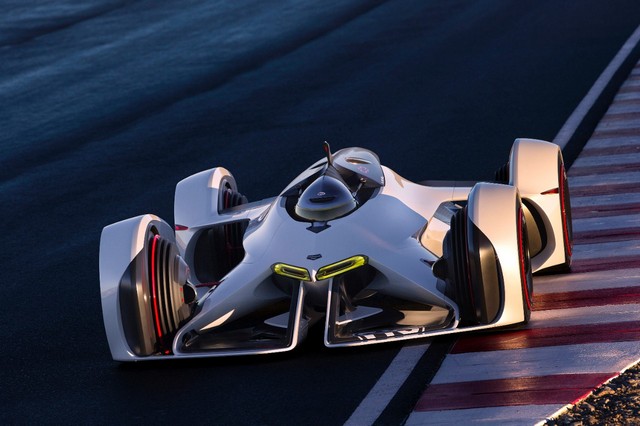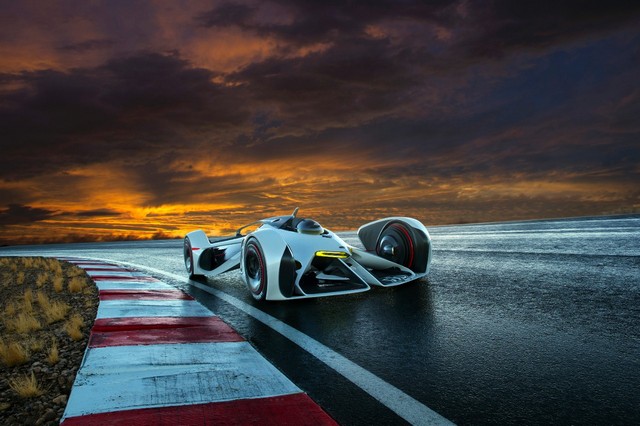AND ANOTHER THING.
 Monday, February 22, 2016 at 08:42AM
Monday, February 22, 2016 at 08:42AM Editor's Note: Peter is so underwhelmed by the debut of the 2016 F1 cars - he termed them "hideous" and "uninspired" - that he's taken this week off from writing his "Fumes" motorsports column. He will return next week. You can see more of his comments on F1 in his AutoextremistTV "The High-Octane Truth" No. 13 video (below), and you can get his take on the Daytona 500 in "The Line." -WG
By Peter M. De Lorenzo
Detroit. After finishing off last week as the most unpopular motorsports commentator in the world for having the temerity to suggest that a radical solution to rejuvenate Formula 1 might in fact be the blending of Formula 1 and Formula E, the more I think about it the more it makes perfect sense unless, of course, you are of the mind that we should set the clock back to an acknowledged "better" time in F1 (pick your era), when the screams of the engines weren't watered down by political correctness. And, as I admitted last week, that would be comforting and seductively compelling, if we wanted to live in a motorsport vacuum of our own creation.
But - and this is a big "but" - then the question begs to be asked, if that's what you would prefer F1 become again, does that mean that F1 should abandon its traditional role as being the "pinnacle" of advanced automotive technological development? And if that is the case, then wouldn't F1 ultimately become a most radical and entertaining form of spec racing in its quest to go back to the future? Because in reality that's exactly what those who would want to turn the clock back to a simpler, gentler time are suggesting. And as tempting as that idea is, it really is a nonstarter for me. And a nonstarter for the future of the sport as well.
Why? Because you simply can't put the technology "genie" back in the bottle. You can't put 60 years of aerodynamic development in racing aside and pretend that it just didn't exist. The same can be said for tire development, the emergence of radical new materials, new engine concepts, and all of the other myriad advancements in technology that are part and parcel of today's racing (we're not referring to NASCAR in this discussion because as we well know it simply exists its a world of its own making). And if you in fact can't put the technology "genie" back in the bottle then wouldn't a de-radicalized F1 become nothing more than a glorified nostalgia exercise?
Let's think about that for a moment. The reason I suggested the blending of F1 and Formula E is that the all-electric series has a huge development curve in front of it. The sky is the limit basically, because fully electric vehicles and hydrogen-powered electric fuel cell vehicles are at the very beginning of their development and their potential. As much as I personally like the scream of a Cosworth-Ford V8 or a Honda V10 or Ferrari V12, I know that by defaulting to that setting this sport would stagnate and eventually fade away. Racing must embrace the future in order to reassert its role as a developer of advanced automotive technologies.
And as much as I would love to see a F1 field filled with naturally-aspirated 1000HP+ screamers, I have to admit I would much rather see something like the Chaparral 2X Vision Gran Tursimo (VGT) concept that Chevrolet unveiled a year and a half ago. Chevrolet termed the Chaparral 2X VGT concept as a "revolutionary interpretation of the ultimate race car, developed exclusively for fans of the PlayStation® 3 racing game, Gran Turismo® 6." But it was more than just a video game concept, it was a visionary "what if" that to me opens up completely new avenues of potential for motorsport.
“It was created in a no-rules atmosphere to challenge designers and test engineers to deliver the most exhilarating sensations. This is a fantasy car by design,” said Frank Saucedo, who oversaw the team that worked on the concept. “Like the original Chaparral race cars decades ago, the Chaparral 2X VGT weaves advanced aerospace technologies into the design to help achieve its performance goals.”
Other intriguing details about the Chaparral 2X VGT concept? Its propulsion system is "inspired by technology derived from advanced work targeted at space travel and future aircraft design" featuring "a mid-mounted laser beamed-energy propulsion system, which pulses beams of light that focus in a shroud, creating shock waves that generate tremendous thrust in the lightweight race car." I have no idea what any of that means, but don't you think such creative geniuses as Colin Chapman or Smokey Yunick would find it to be intriguing and be all for it?
According to the fantasy stats for the wildly inventive machine, the Chaparral 2X VGT is equipped with a 671-kW laser, powered by a pack of lithium-ion batteries and an air-powered generator to provide 900 horsepower worth of thrust, 0-60 acceleration capability of 1.5 seconds and a top speed of 240 mph. And there's more. The propulsion system’s position in the composite chassis complements an unconventional yet highly active prone driver configuration – face down with the driver’s arms and legs splayed toward the wheels. In fact, the race car’s propulsion and suspension systems are built around the driver, enabling progressive strategies of active and driver-adjustable aerodynamics.
“Think of it as adapting a wing suit to a racing car, where the driver’s movements control certain aspects of the aero package,” said Saucedo. “In many ways, the Chaparral 2X VGT is like racing wing suit, with a protective fuselage for ‘flying’ very low to the ground.” The driver-enabled aerodynamics eliminate the need for large, conventional wings and other aero devices used to generate grip-enhancing downforce – an attribute that helps reduce the overall mass of the Chaparral 2X VGT’s minimalist structure. Only essential elements are on board, with instrumentation, for example, projected on the driver’s helmet visor.
I don't know about you, but I for one would wholeheartedly embrace this kind of visionary thinking for racing. There is no denying that throughout the history of this sport it has been inspired by creative geniuses with visionary perspectives and a clear aversion to the status quo. That's why the future of this sport - and the future of Formula 1 in particular - hinges upon that same kind of truly innovative thinking combined with the kind of indomitable spirit that has propelled the sport forward in the past.
And that's why its time to pay homage to the greatness of the past, while writing exciting new chapters for the future.
And that's the High-Octane Truth for this week.
 (Chaparral 2X VGT images courtesy of Chevrolet)
(Chaparral 2X VGT images courtesy of Chevrolet)



Check out the latest episode of The High-Octane Truth on AutoextremistTV below. -WG
Note that this week's episode is a two-parter...you can see Part 2, plus all episodes of AETV, here!
Editor's Note: Many of you have seen Peter's references over the years to the Hydrogen Electric Racing Federation (HERF), which he launched in 2007. For those of you who weren't following AE at the time, you can read two of HERF's press releases here and here. And for even more details (including a link to Peter's announcement speech), check out the HERF entry on Wikipedia here. -WG
Publisher's Note: As part of our continuing series celebrating the "Glory Days" of racing, we're proud to present another noteworthy image from the Ford Racing Archives. - PMD

(Photos courtesy of the Ford Racing Archives)
Sebring, Florida, March 26, 1966. Dan Gurney and Carroll Shelby talk before his last night pit stop, where he would take over from Jerry Grant for the finish. Gurney and Grant (No. 2 Shelby American Ford Mk II) were the pole sitters, with Gurney turning a lap of 2:54.6 seconds. The Gurney/Grant Ford led almost the entire race, but the machine suffered a timing chain failure within site of the start/finish line just before 10:00 p.m. end of the race. Gurney pushed the car to the finish line but was disqualified, because it was against the rules. If he hadn't pushed it, the car would have been classified as the second place finisher. The Ken Miles/Lloyd Ruby No. 1 Ford X-1 roadster (below) won the race, followed by Walt Hansgen/Mark Donohue (No. 3 Holman & Moody Ford Mk II) and Skip Scott/Peter Revson (No. 19 Essex Wire Corporation Ford GT40). Watch a video here.

Publisher's Note: Like these Ford racing photos? Check out www.fordimages.com. Be forewarned, however, because you won't be able to go there and not order something. - PMD




